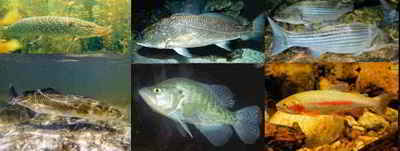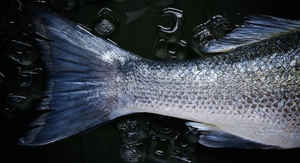Nebraska State Fish
Channel Catfish

(Ictalurus punctatus)
Adopted on September 13, 1997.
In 1997, the Nebraska Legislature approved Legislative Bill No. 106 (LB106) giving the governor of Nebraska the authority to declare official "state
items" without legislative approval. On September 13, 1997, Gov. Ben Nelson declared the channel catfish, (Ictalurus punctatus,)
to be Nebraska official state fish. The channel catfish is a popular sport fish that is often used for food.
Nebraska State Fish: Channel Catfish

Channel catfish closely resemble blue catfish. Both have deeply forked tails. However, channels have a rounded anal fin with 24-29 rays and scattered black spots along their back and sides. They have a small, narrow head. Channel catfish have eight barbels (whiskers). The back is blue-gray with light blue to silvery-gray sides and a white belly. Larger channels lose the black spots and also take on a blue-black coloration on the back which shades to white on the belly. Males also become very dark during spawning season and develop a thickened pad on their head.
Common Names
Spotted cat, blue channel cat, fiddler, river catfish, great lakes catfish, lady cat
Characteristics of the Nebraska Channel Catfish
Subspecies
There are no recognized subspecies. However, on rare occasions, they hybridize with blue and flathead catfish. Aquaculturists recognize numerous hatchery stocks and create a variety of hybrids to improve their culture characteristics.
Range
Channel catfish inhabit deep streams, rivers, and lakes in eastern and central US, especially in deep stretches of sand, gravel, or rubble bottom. They also inhabit lakes, reservoirs, and ponds. The preferred water temperature is 75-80 °F.
Habitat
Most common in big rivers and streams. Prefers some current, and deep water with sand, gravel or rubble bottoms. Channel catfish also inhabit lakes, reservoirs and ponds. They adapt well in standing water where stocked.
Spawning Habits
Spawning occurs mostly in rivers and streams in the spring and early summer when waters warm to 70 to 85 degrees. They also will spawn in larger lakes where suitable habitat is available. Eggs are deposited in nests secluded under banks or logs or over open bottom. The male selects the site, often a natural cavern or hole, clears the nest and guards the eggs and young. A female may lay 2,000 to 21,000 eggs that hatch in six to 10 days depending on water temperature. Males protect the fry until they leave the nest in about a week.
Feeding Habits
Feeds primarily at night using taste buds in the sensitive barbels and throughout the skin to locate prey. Although they normally feed on the bottom, channels also will feed at the surface and at mid-depth. Channel catfish feed on insect larvae, clams, snails, crayfish, crabs, and aquatic plants. They locate food by probing the bottom with their barbels. Small channels consume invertebrates, but larger ones may eat fish.
Age and Growth
Maximum size attained is about 20 pounds. The fish's weight generally averages two to four pounds. Studies indicate 11 years as the maximum age, but some fish probably live 15 to 20 years.
Length: Up to 24 inches
Weight: Up to 20 pounds
Life span: Up to 11 years
Nebraska Law
CHAPTER 90 - Special Acts.
SECTION 90-107.
Governor; designate official state items. The Governor may designate official state items, including animals, plants, minerals, and
other things. Legislative approval of any such designation is not required. Any designation made on or prior to September 13, 1997, is not affected
by this section.
Source Laws 1997, LB 106, § 1.
Taxonomic Hierarchy: Channel Catfish
Kingdom: Animalia - animals
Phylum: Chordata - chordates
Subphylum: Vertebrata - vertebrates
Class: Osteichthyes
Subclass: Actinopterygii
Order: Siluriformes
Suborder: Siluroidei
Family: Ictaluridae
Genus: Ictalurus
Species: Ictalurus punctatus








